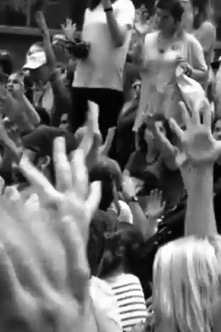Deutsch
Es sieht aus wie der Morgen nach einem Rockfestival, ein Durcheinander aus zerlumpten Schlafsäcken. Doch die Demonstranten im Protest gegen die Wall Street haben eine funktionsfähige Stadt innerhalb der Stadt erschaffen, eine kleine, funktionierende Demokratie. Es gibt Arbeitsgruppen für Essen, Sicherheit, Erste Hilfe, sanitäre Anlagen, juristische Hilfe und Internetzugang. Es gibt sogar eine Bibliothek. Ein Generator erzeugt Strom für Computer und Ladegeräte. Eine Generalversammlung aller, die sich beteiligen möchten, trifft sich zweimal täglich. Da es schwierig ist, durch den Lärm von Lower Manhattan gehört zu werden, und da die Stadt keine Megafone oder Lautsprecher erlaubt, haben die Protestierenden ein Gebärdensystem entwickelt. Finger nach unten heißt, dass man nicht einverstanden ist. Verschränkte Arme bedeuten, dass man überhaupt nicht einverstanden ist. Ansagen werden per ›People’s Mic‹ gemacht. Wenn es etwas bekannt zu machen gibt, sagt man es und die Menschen in unmittelbarer Umgebung wiederholen die Ansage und geben sie so weiter. Die Teilnehmer der Occupy-Wall-Street-Proteste gegen die Habgier der Unternehmen haben nach eigenen Angaben keine Anführer, sondern treffen Entscheidungen per Konsensprinzip.
(Karen Matthews)
Macht euch auf Jargon gefasst: Die Generalversammlung ist ein horizontales, autonomes, anführerloses, im anarchistischen Gedankengut verwurzeltes System, das von einem modifizierten Konsensverfahren Gebrauch macht. Es ähnelt den Versammlungen, die jüngste soziale Bewegungen angetrieben haben, in Orten wie Argentinien, Ägyptens Tahrir-Platz, Madrids Puerta del Sol usw. Per Konsens zu arbeiten ist schwierig, frustrierend und langsam. Doch die Besetzer nehmen sich Zeit. Wenn sie zu einem Thema endlich einen Konsens erreicht haben, oft nach etlichen mühevollen Tagen, ist die Stimmung unglaublich. (…) Und zum Glück müssen sie nicht zu allen Themen einen Konsens erreichen. Letztendlich ist die Hoffnung, dass jede/r einzelne befähigt ist, als er/sie selbst Entscheidungen zu treffen und zu handeln – zum Wohle der Gruppe.
(Nathan Schneider)
James Saunders
Unter Verwendung des Modells dezentralisierter und selbstorganisierter Netzwerke funktioniert »distribution study« als Komposition für persönliche, verteilte Aufführungen. Die Umsetzungen des Stückes, aufgeführt in der Pinakothek der Moderne in München während des Jahres 2011, katalysieren die Entstehung eines Verteilernetzwerks der Partitur. Individuell nummerierte Kopien der Partitur werden den Besuchern frei zugänglich gemacht, die sie wiederum an Empfänger weitergeben können, die bereit sind, dasselbe zu tun. Dieser Austausch wird durch eine Website kartiert, die zeigt, wie zwischenmenschliche Kommunikations-netzwerke die Ausbreitung von Information formen können.
English
It looks like a rock festival the morning after, a tangle of tattered sleeping bags. But the demonstrators taking part in the protest against Wall Street have created a functioning city within the city, a small, working democracy. There are task forces in charge of food, security, first aid, sanitation, legal help and Internet access. There’s even a library. A generator supplies power for laptops and cell phone chargers. A general assembly of anyone who wants to attend meets twice daily. Because it’s hard to be heard above the din of lower Manhattan and because the city is not allowing bullhorns or microphones, the protesters have devised a system of hand symbols. Fingers downward means you disagree. Arms crossed means you strongly disagree. Announcements are made via the ›people’s mic.‹ If you need to announce something — someone`s wallet has been found, there`s a march at noon — you say it and the people immediately around you repeat it and pass the word along. Participants in the Occupy Wall Street protests — organized to decry corporate greed and the gap between the rich and poor — say they have no leaders but are making decisions by consensus.
(Karen Matthews)
Get ready for jargon: the General Assembly is a horizontal, autonomous, leaderless, modified-consensus-based system with roots in anarchist thought, and it’s akin to the assemblies that have been driving recent social movements around the world, in places like Argentina, Egypt’s Tahrir Square, Madrid’s Puerta del Sol and so on. Working toward consensus is really hard, frustrating and slow. But the occupiers are taking their time. When they finally get to consensus on some issue, often after days and days of trying, the feeling is quite incredible. […] Fortunately, though, they don’t need to come to consensus about everything. In the end, the hope is that every individual is empowered to make decisions and act as her or himself, for the good of the group.
(Nathan Schneider)
James Saunders
Taking the model of a decentralized and self-organising network, »distribution study« operates as a composition made for personal, distributed performance. Realisations of the piece performed at the Pinakothek der Moderne in Munich during 2011 catalyse an emergent score distribution network. Individually numbered copies of the score are made freely available to visitors, who may distribute them to willing recipients, who may in turn do the same. These exchanges are mapped via a website, showing the way in which interpersonal communication networks can shape the dissemination of information.
Quellen / sources:
ap.org
thenation.com
youtube.com
(Letzter Zugriff / last access: 11. 10. 2011)
